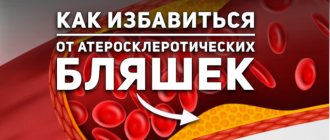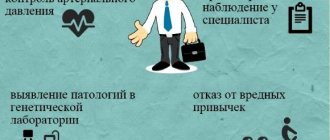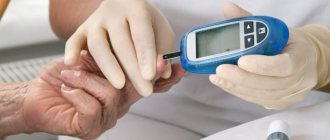1 million 300 thousand people die annually from cardiovascular diseases - this is the population of a large city. 13% of all these diseases occur due to heart attack. The risk group includes women and men aged 56-66 years. According to statistics, the mortality rate from this disease remains high (up to 30-35% of cases in the acute form), despite the fact that new methods have emerged to solve the problem.
The outcome of the disease largely depends on the timeliness of visiting a doctor and correctly provided first aid. We'll tell you how to recognize the pathology by the first symptoms, and what to do before the ambulance arrives, so as not to die.
What is a heart attack - medical definition
Before deciphering the word “heart attack,” we need to consider how the heart works normally and what happens to the organ during a heart attack.
The main function of the heart is to move blood through the vessels and ensure the vital functions of all systems and organs. The heart itself is also supplied with blood through two coronary arteries. If they become blocked, then a certain area of the heart muscle will cease to be supplied with blood. As a result, necrosis of cardiac tissue develops. This is myocardial infarction from a medical point of view.
During a heart attack, part of the heart muscle dies permanently.
Causes and risk factors
A heart attack is a phenomenon in which the heart muscle is partially damaged or dies as a result of insufficient oxygen supply. The vessels that supply the heart with blood and oxygen are called coronary arteries. Their blockage reduces blood flow to the heart and causes a lack of oxygen.
Most heart attacks are the result of blocked coronary arteries. The general name for this disorder is coronary heart disease. In it, blood flow in the arteries is impaired due to the accumulation of a sticky substance called plaque on the walls. A disease in which plaque builds up is known as atherosclerosis. Plaque builds up on artery walls over a period of years, and when damaged or detached, a clot can form. This, in turn, can slow or completely cut off blood flow to the heart, causing it to stop receiving enough oxygen. And when oxygen is not supplied to the tissue, it begins to die.
The main risk factors for developing a heart attack include:
- smoking
- diabetes
- age. In men, the risk increases after 45 years, in women - after 55 (or after menopause). According to statistics, about 83% of people who died from a heart attack were over 65 years of age.
- high blood cholesterol
- high blood pressure
- elevated blood sugar
- cases of heart attack among close relatives
- race. People from certain races and from certain regions are at greater risk of developing a heart attack.
- lack of physical activity
- stress
- obesity
- floor. Men are more likely to have a heart attack. At the same time, cardiovascular diseases are the main cause of death among women in many developed countries.
A less common cause of heart attack is severe spasm or compression of a coronary artery. This can happen regardless of the accumulation of plaque inside the artery, but the result is the same, namely, interruption of blood flow. Spasms as a cause of heart attack are still poorly understood. Today they are associated with:
- taking certain drugs such as cocaine
- smoking tobacco
- exposure to very low temperatures
- severe emotional shock or stress.
What is a heart attack in simple words and how does it differ from a stroke?
In order to better understand what the disease is, it is necessary to give it a simpler interpretation. Myocardial infarction (MI) is a heart disease associated with impaired blood flow to the heart. This condition is life-threatening and can be fatal if first aid is not provided correctly.
People often wonder how a heart attack differs from a stroke. The key difference is that in the first case the heart muscle is affected, and in the second - parts of the brain .
Prevention
A healthy lifestyle can prevent heart attacks. It includes:
- Quitting smoking (if you smoke), including passive smoking.
- Eating a healthy diet that is low in fat and cholesterol.
- Regular physical activity.
- Minimizing stress levels.
- Controlling blood pressure.
- Maintaining normal blood sugar levels (diabetes).
- Visit your doctor regularly for check-ups.
I am a woman. Can estrogen replacement therapy reduce the risk of heart attack?
Hormone replacement therapy or estrogen replacement therapy is used to treat menopausal symptoms. For some time it was believed that it could also help with certain diseases, including cardiovascular diseases. However, recent studies have shown that hormone replacement therapy does more harm to the heart than good. Therefore, if you are using it to prevent a heart attack, discuss the advisability of such treatment with your doctor.
Types of MI and their danger to life
There are several classifications of the disease depending on the criteria: the stage of development of the disease, the extent of heart damage and the cause of necrosis.
In its development, MI goes through 5 main stages:
- Beginning . It lasts up to 1.5 months. If you consult a doctor in a timely manner, you can avoid a heart attack and be cured without surgery. This stage lasts 1.5 days to 1.5 months.
- The sharpest one . It develops if a person was not promptly provided with medical assistance at stage 1. The attack lasts only 2 hours, but it is at this moment that the greatest number of deaths from heart attacks is noted.
- Spicy . Lasts up to 10 days. During this period, a zone of necrosis is finally formed. The cells in the affected area are replaced by scar tissue. The acute stage is also life-threatening because it is complicated by pulmonary edema and cardiogenic shock.
- I'll sharpen it up . This stage lasts up to 8 weeks. Characterized by the formation of scars in the heart area.
- Restorative . The period of scarring of the affected tissue lasts up to 6 months. It is dangerous for the development of a second heart attack.
Recurrence of pathology after a heart attack increases many times over.
Based on the extent of damage to the heart muscle, infarction is divided into 3 types:
- Finely focal . With this form, endocarditis, the lining of the heart or its middle layer, is affected. In severe cases, with a small focal infarction, all 3 sections are subject to necrosis, but the person still has a high chance of survival. The peculiarity of the disease is that the heart does not always form scars that are visible on the cardiogram.
- Large-focal . In 50% of cases, patients do not survive the attack. Necrosis extends to the coronary arteries and cardiac muscles. Large-focal infarction occurs as a relapse of the small-focal form.
- Extensive . This is the most dangerous type of pathology, since it affects most of the heart muscle. In almost all cases, the consequence of a massive heart attack is death.
Clinical classification of MI, presented by the European Society of Cardiology and the World Heart Association:
- 1 Type. It is associated with the primary blocking of the heart vessels by plaque.
- 2 Type. Occurs against the background of an already suffered attack due to lack of oxygen or a sharp decrease in blood pressure.
- 3 Type. Sudden coronary death or cardiac arrest.
- 4 Type. Associated with coronary angioplasty and stenting.
- 5 Type. This is a myocardial infarction caused by coronary artery bypass grafting.
If you need a consultation, get it for free on the Doctor Online website.
Video
We offer you to watch a video on the topic of the article.
Associated with serious changes in the heart area. Some cells die and are replaced by connective tissue, the functioning of an important organ deteriorates, which leads (although not always) to death. But if you identify the pathology at an early stage, knowing how to determine a heart attack yourself at home, you will be able to avoid life-threatening consequences.
The obvious symptoms of a heart attack are difficult to confuse with signs of other diseases, and you need to be able to recognize them in order to be able to provide timely assistance. Primary symptoms are associated with the appearance of pulmonary edema, fear of death, pain in the chest, etc.; they can start suddenly or be the most unexpected. Some patients experience an attack on their feet and do not even realize that they were near death.
Myocardial infarction affects people of all ages; recently, even young people are not immune from it. But according to statistics, most often a heart attack develops in men 40-60 years old. Women, due to the characteristics of their bodies, are susceptible to cardiac pathology 1.5-2 times less often; they usually suffer from it in postmenopausal age, while women in their youth are protected by hormones.
The first manifestations differ among representatives of different sexes. This is due to hormonal and constitutional differences.
Signs in men
A pre-infarction state is observed in men before an attack occurs. Precursors, as a rule, appear within 3-7 days. A heart attack can be spontaneous or repeated (relapse). As the attack approaches, the symptoms become more severe. The onset of the acute phase is characterized by rapid heartbeat and acute pain in the chest (left or middle). In men, unpleasant sensations radiate to the stomach and muscles, sometimes to the jaw, and the pain spreads to the entire right side of the body. Large cardiac arteries are affected.
The first symptoms of a heart attack in men of any age are:
- pain radiating to the shoulder blade, back, neck, etc.;
- numbness in the chest;
- toothache;
- periodontal disease and bleeding from the gums;
- increased sweating;
- lethargy;
- decreased blood pressure;
- sleep disturbance, etc.
There are atypical cases that are difficult to diagnose. Vague symptoms force you to self-medicate and endure an attack on your feet, which is fraught with relapse. But any repetition of the manifestations presented above should alert a person. This especially applies to men who are at risk: smokers, diabetics, etc.
Signs in women
Women can recognize a heart attack much earlier, as its impending signs appear within 2-4 weeks. Malaise is felt several days before a heart attack, but the symptoms are less pronounced. The differences are due to the fact that the heart in women is located a little to the left, it is smaller in size and is accustomed to heavy loads (childbirth). The pulse is slightly faster and usually remains unchanged during an attack. The same goes for pressure. In addition, during an attack in women, unlike men, small vessels become clogged.
Signs of a heart attack are varied and can be as follows:
- numbness of the limbs;
- unmotivated fatigue (even after sleep);
- burning sensation in the lower abdomen;
- indigestion;
- frequent urge to urinate;
- heaviness and pain in the chest;
- spasms in the bronchi;
- discomfort in the jaw area;
- pain in the back of the head;
- swelling of the legs;
- anxiety;
- panic attack, etc.
How to recognize a heart attack - the first signs of the disease, reviews from doctors and patients
When a myocardial infarction occurs, doctors have very little time to help the person and save him. Therefore, it is important to know about pre-heart attack symptoms in order to go to the clinic in time and have your heart checked. All symptoms of the disease are divided into typical and atypical. Let's consider everything to know more about the manifestations of the disease.
The first typical sign of myocardial infarction is chest pain. The spasm is squeezing, pressing and burning in nature. It can radiate to other parts of the body: shoulders, neck, lower jaw or area under the shoulder blades.
Feedback from a physician of the highest category, Larisa Alekseevna Smirnova: “You can distinguish a heart attack from other heart diseases by the nature of the pain. With MI, spasms appear not only in the chest, but also in the lower jaw, shoulders and arms.”
The second symptom characteristic of the pathology is arrhythmia. It is manifested by increased heart rate and a feeling of anxiety for one’s own life. Doctors call this type of MI arrhythmic.
A heart attack does not always begin with chest pain and increased heart rate. Mature people sometimes experience atypical symptoms of a pre-infarction state. For example, cramps may not occur behind the sternum, but in the upper abdomen. At the same time, the patient experiences gastrointestinal disorder:
- nausea;
- vomit;
- bloating.
A heart attack with such symptoms is called abdominal.
In old age, MI often begins with attacks of suffocation, when the patient feels a lack of air. This is an asthmatic type of disease. Emergency medical attention is necessary even if there is no chest pain. Self-medication can lead to pulmonary edema and sudden death.
The onset of myocardial infarction can be combined with impaired brain function (cerebral form):
- memory impairment;
- speech disorder;
- disturbance of consciousness;
The symptoms are explained by the fact that with necrosis of the heart muscle, cardiac output decreases and a pronounced spasm of cerebral vessels occurs.
A heart attack can occur in an asymptomatic form. This is typical for patients whose sensitivity of nerve endings decreases due to diabetes. The only symptoms indicating health problems are chest discomfort, depressed morale, weakness, and sleep problems.
Reviews from patients
Elena is 32 years old. A heart attack can be recognized not only by chest pain. Shortness of breath and dizziness are additional symptoms that require consultation with a doctor. Those who suffer from hypertension may not experience pain at all, but will experience pale skin, panic attacks and rapid heartbeat.
Stages of heart attack
Myocardial infarction is characterized by stages. Thus, there are several stages in the development of the disease:
- Pre-infarction period.
- The most acute stage. Occurs after 5-6 hours from the moment signs of a heart attack appear in men and women. At this time, oxygen stops flowing to the heart muscle.
- Acute phase. It is accompanied by the formation of areas of necrosis, the duration is, on average, 14 days, complications may develop.
- Subacute period. Stretches for 2 weeks. Dead myocardial cells are gradually replaced by scar tissue, and less “damaged” lesions restore their “healthy” functioning.
- Scar stage. It occurs a month after the attack and is characterized by the appearance of an extensive area of scarring. This part of the heart does not participate in the work of the organ, does not conduct nerve impulses, the functional load “passes” to other parts of the myocardium, conductivity changes its direction - in connection with this, patients experience arrhythmia.
- Post-infarction period. Scar changes are replaced by dense connective tissue.
First aid for a heart attack - what to do so as not to die
If a person has an attack and there is no one nearby who can help, then you need to do the following:
- Take medications that thin the blood and prevent blood clots from blocking blood vessels. A safe drug is Aspirin; it will delay pathological phenomena in the heart muscle for several hours.
- Use nitro-containing drugs - Nitroglycerin. The medicine is taken 1 tablet every 15 minutes. Nitroglycerin can be taken only in cases where blood pressure is not reduced and there is no state of alcohol intoxication.
- Call an ambulance.
Those who provide first aid to the victim need to be aware of additional measures:
- Provide the patient with access to oxygen. If he is in an apartment, then you need to open all the windows.
- Help the victim take a more correct body position - half-sitting or lying with his head raised.
- Perform chest compressions if the patient has lost consciousness. To do this, press on the victim’s chest with your palms at a frequency of 100 times per minute. Resuscitation actions will help restore blood circulation.
Leave a request to consult with a doctor.
Feeling of tightness in the chest
As a rule, cardiovascular risk makes itself felt. For example, already a month before a heart attack, people feel tightness, pain and heaviness in the chest. Unpleasant sensations may be accompanied by a burning sensation in the chest area and the inability to breathe deeply.
The star of the series “Sultan of My Heart” spoke about the choice of his future wife
Only on a soft spot: Russian Domostroy forbade punishing children in any other way
Seven daily habits of happy people
If you notice these signs, we recommend that you regularly measure your blood pressure and replenish your first aid kit with antihypertensive medications. Do not hesitate and go for examination to a therapist, as these symptoms may also be associated with cervical osteochondrosis or arrhythmia.
Medical diagnosis of heart disease - description of laboratory procedures by a doctor
Reanimatologist A. V. Shpector talks about how the diagnosis of a life-threatening condition is carried out.
“Diagnosing acute MI has become easier thanks to the ability to determine the level of cardiac-specific troponin in the blood of patients. Myocardial infarction is detected even if a small area of the heart muscle dies. However, the test has a main drawback - from its results it is impossible to say for what reason the death of the cardiomyocyte occurred. In fact, pathology in 65% of cases develops due to severe somatic diseases not related to the heart.
Diagnosis of MI worldwide is based on the III International Consensus. It says that for an accurate diagnosis of myocardial infarction, a combination of cardiac markers with signs of myocardial ischemia is necessary.
Doctors can tell that a patient has had a heart attack only if an increase in cardiac-specific troponin is combined with characteristic signs of a heart attack on an echocardiogram.”
Other symptoms that should alert you
Sometimes the symptoms are less specific and harder to recognize. This may be barely noticeable pain from radiation or symptoms of gastrointestinal dysfunction. Sweating, malaise, feeling hot, and palpitations can also be early signs of a heart attack.
The heart attack is subsequently detected by an electrocardiogram, performed, for example, during an examination.
Any chest pain that suggests a heart problem should make you think about a heart attack and dial 911 as soon as possible. Statistics show that accidents due to heart disease most often occur in the morning. Don't be afraid to call in an emergency, even if you're not sure of the diagnosis, it could save a life! From landline 03 and from mobile 103.
Treatment of myocardial infarction - clinical recommendations from doctors
Pathology therapy is carried out only in a medical institution. MI cannot be treated at home. A patient who has had an attack is admitted to the intensive care unit or intensive care unit. Only under such conditions is it advisable to dissolve blood clots in the vessels and relieve spasm in the coronary arteries.
People diagnosed with myocardial infarction do not always require surgery. If a type 2 heart attack is diagnosed, then it is necessary to treat the underlying disease that caused the recurrence of myocardial infarction. In this case, there are cholesterol plaques in the vessels, but there are no blood clots that would block the blood flow to them. Therefore, stenting and coronary angioplasty will be useless.
If the vessel is blocked by a blood clot or a burst cholesterol plaque, then help is provided to the victim immediately. Doctors restore blood flow with medication or through emergency intervention.
Stenting
A low-traumatic method of surgical intervention is coroplasty and stenting. Today there is no better method than this - it is a generally accepted worldwide tactic for treating patients with acute myocardial infarction. Operation stages:
- A special contrast agent is injected into the patient's heart vessels. With its help, the resuscitator can understand: where the source of the problem is, whether a vessel or artery is completely or partially blocked.
- A catheter and balloon are inserted into the problem area to remove the clot and restore circulation.
- After the procedure, a supporting stent—a mesh-metal frame—is installed at the site of the narrowing of the vessel. It prevents the arteries from narrowing and ensures normal blood flow to the heart muscle.
The basic principle for the treatment of acute myocardial infarction, according to the latest European guidelines 2020: “Primary angioplasty and stenting should be performed on as many patients as possible within 120 minutes of presentation to a medical facility.”
Thrombolysis
If it is not possible to stent the vessel earlier than 2 hours, then patients undergo thrombolysis. Doctors inject special drugs into the patient’s bloodstream that dissolve blood clots, and only then perform stenting.
Bypass surgery
An alternative treatment method to stenting is coronary artery bypass grafting. This is an abdominal operation that is performed under general anesthesia. It is prescribed to patients who did not go to the emergency room in time and there is no way to restore blood circulation with the help of stenting. Shunts are bypasses through which the heart is supplied with blood, bypassing areas affected by atherosclerosis. They are made from the arteries and vessels of the victim.
Drug treatment
Installing a stent and shunt does not solve all problems in the heart. He needs to take medications to prevent the recurrence of blood clots in his arteries. The medications you will need to take after surgery are Aspirin and Ticagrelor.
The doctor prescribes an additional list of medications based on the clinical symptoms of the disease. For example, to relieve heart pain, patients are recommended to take narcotic painkillers - Morphine or Promedol. If arrhythmia is observed after the operation, then to reduce the heart rate you will need to take beta blockers - Metoprolol or Atenolol.
It became known that from 2020, people who have suffered a myocardial infarction will receive free medicines in Russia.











